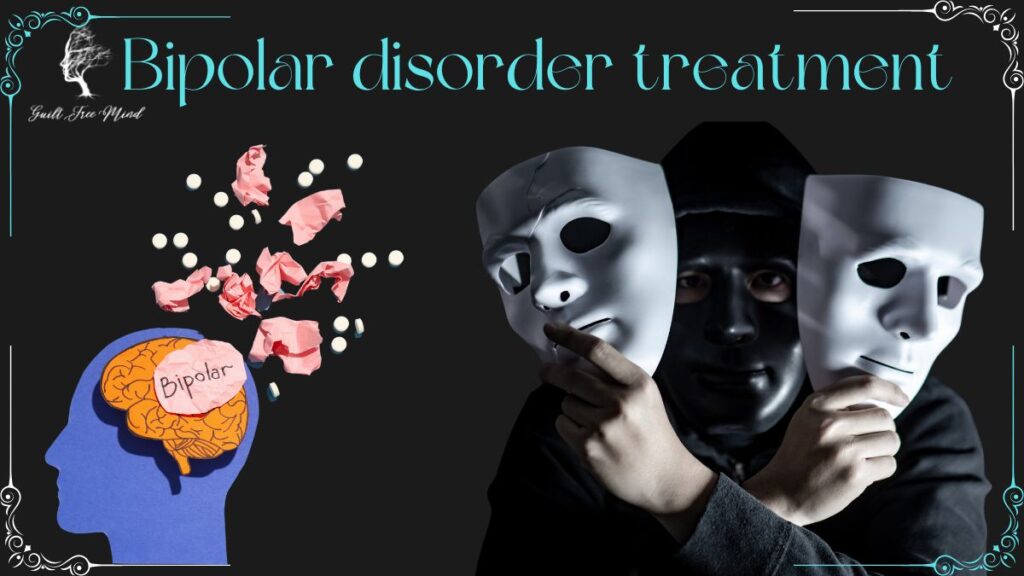Bipolar disorder (manic depression or manic-depressive illness) is a mental health condition characterized by extreme alterations in mood, energy levels, thought processes, and behavior. These changes can hinder your ability to go about your routine for several hours, days, weeks, or months. The bipolar disorder treatment includes medication and alternative therapy.
Hypomanic, manic, and depressed periods are some of the characteristics of bipolar disorders. People with bipolar disorder can experience states other than hypomania/mania or depression. They may also experience periods of euthymia. These episodes frequently last for several weeks or months and cause severe impairment in everyday life and work. In this blog post, I will discuss what bipolar disorder is, the symptoms, and the bipolar disorder treatment options, so that those suffering from this mental health condition can lead a happy, fulfilling, and successful life.
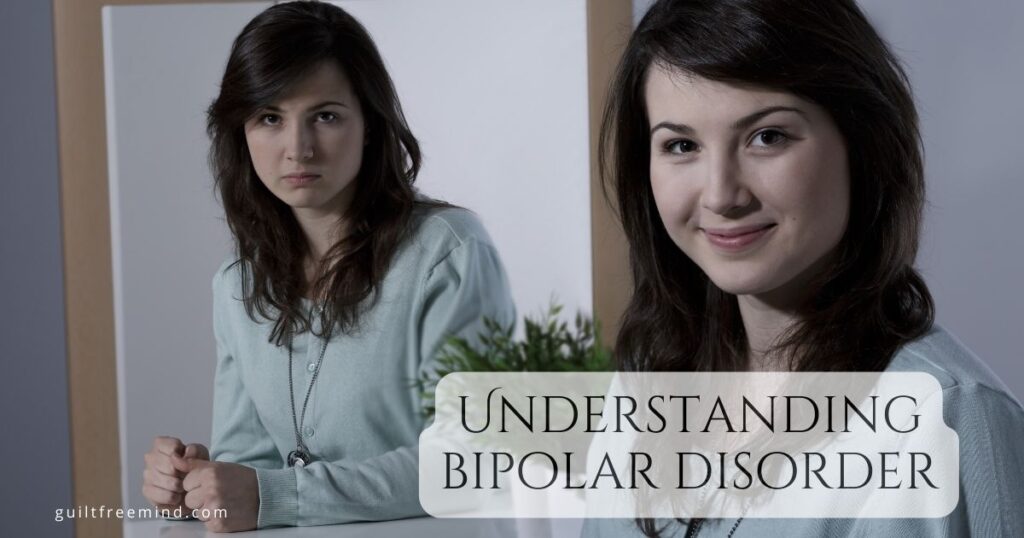
Do you want to know more about bipolar disorders, their treatment modes, and how to manage them effectively? If your answer is yes, then you should subscribe to the Guilt Free Mind blog. The subscription option is present in the sidebar. If you like watching videos, subscribe to the YouTube channel of Guilt Free Mind. Remember to ring the notification bell and set it to all so that YT notifies you every time a new video is releases.
Table of Contents
Why is there a need for bipolar disorder treatment?
Many people with bipolar disorder can live productive lives with the help of treatment and community resources. To effectively manage the condition and lessen the impact of mood episodes on their overall well-being, people with bipolar disorder must work closely with healthcare providers, stick to their prescribed treatment programs, and engage in self-care practices.
Understanding bipolar disorders
Approximately 2%-3% of people worldwide have bipolar disorder; this condition does not discriminate based on age, gender, or culture. Although its onset is most common in late adolescence or early adulthood, it can also occur in younger or older people. So far, researchers have yet to identify a single cause for bipolar disorder, they have identified several potential contributors, including genetics, biology, and the environment.
Subtypes:
- Bipolar I disorder
- Bipolar II disorder
- Cyclothymic disorder
- Other Specified and Unspecified Bipolar and Related Disorders
Those who suffer from bipolar I disorder experience mania, which may or may not be accompanied by depression. Recurrent episodes of depression and hypomania (a milder form of mania) characterize bipolar II disorder. Hypomanic and depressive symptoms, rather milder than those of full-blown episodes, fluctuate chronically in people with cyclothymic disorder.
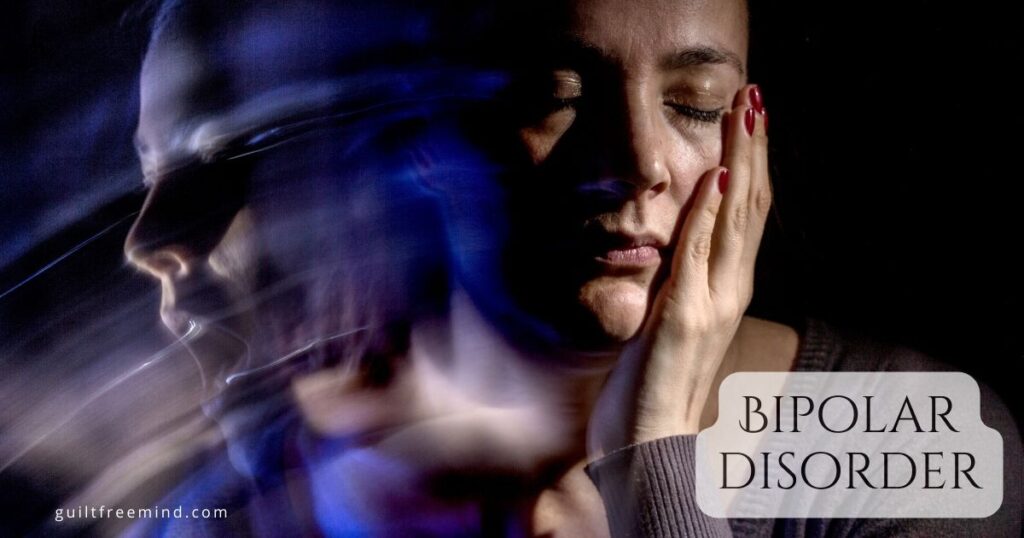
What are episodes of mania?
Manic episodes are one of the primary characteristics of bipolar I disorder. One must have experienced at least one manic episode lasting at least a week, with or without ever having experienced a depressive episode. If these conditions are fulfilled, the person will be diagnosed with suffering from bipolar I disorder.
To be manic, the person must display a state of abnormally heightened or irritable mood, along with a rapid and dramatic shift in feelings, thoughts, energy, speech, and activity levels. Family members or friends may notice a shift from the person’s typical demeanor to a state of heightened alertness in their physical and mental activities.
People experiencing manic episodes are more likely to engage in risky behaviors that endanger their health, relationships, and finances. Psychotic symptoms, such as delusions and hallucinations, can also arise, making it difficult to differentiate bipolar illness from conditions like schizophrenia and schizoaffective disorder. Hypomania is a milder form of mania that can occur in people with specific types of bipolar, such as bipolar II disorder. It doesn’t continue as long and doesn’t hinder daily life as much as mania.
Episodes of depression
- A depressive episode is characterized by several symptoms, including but not limited to:
- Low or depressed mood
- Loss of interest in most activities, and many more.
- Tiredness.
- shifts in food intake.
- Despair
- Lack of belief in one’s future.
When should you opt for bipolar disorder treatment?
Those who suffer from bipolar disorder can greatly enhance their quality of life if they choose to seek therapy. Bipolar disorder is a serious mental illness that can have far-reaching consequences in a person’s personal and professional life. In the case of a lack of bipolar disorder treatment, the symptoms can increase over time and cause serious impairments in everyday life.
The most common symptoms of bipolar disorders like mood swings can be managed and stabilized, and the frequency and severity of episodes are reduced by the use of medications. Furthermore, the general quality of life improved with the support of professional assistance and appropriate treatment modalities, such as medication and therapy. Individuals with bipolar disorder who seek therapy can restore control, learn skills for managing symptoms, and improve their sense of psychological security and well-being.
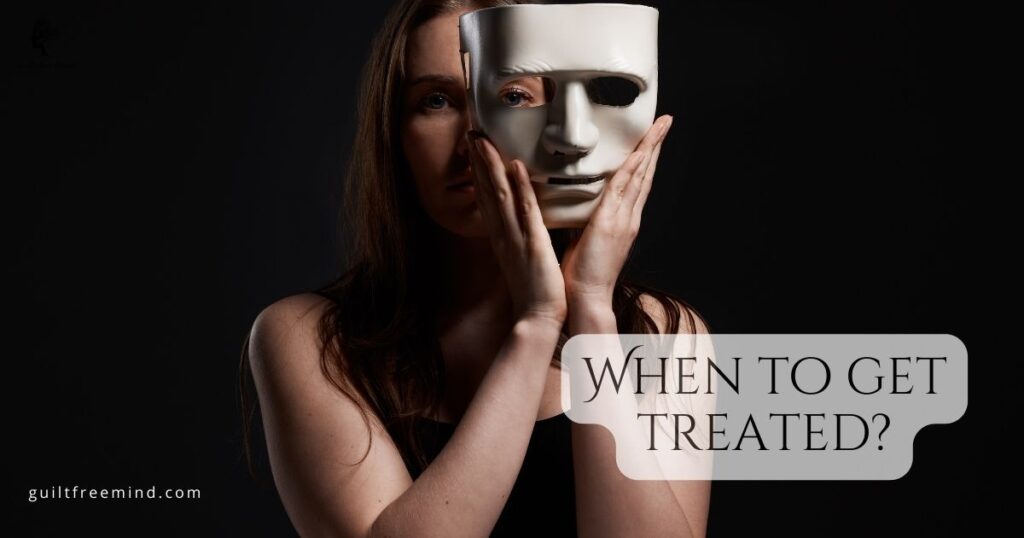
Understanding the types of bipolar disorders
There are four distinct manifestations of bipolar disorder.
Bipolar 1 disorder
Those with bipolar I disorder have experienced mania at some point or other. Mania and depression are both common bipolar I symptoms, but a depressive episode is not required for a diagnosis. Depression bouts typically persist for two weeks or more. A manic episode must persist for at least seven days or be so severe that you need hospitalization for the same. A mixed state, in which a person experiences both manic and depressed symptoms, is also possible for those with bipolar I disorder.
Bipolar II disorders
Hypomanic and depressed episodes characterize the existence of bipolar II disorder. They have symptoms of bipolar I disorder, but they never reach the point of full-blown mania. Bipolar II disorder is typically more disabling than bipolar I disorder because of the prevalence of chronic depression in bipolar II, even if hypomania is less damaging than mania.
Cyclothymic disorder (cyclothymia)
Cyclothymic disorder (cyclothymia) is characterized by the presence of permanent mood swings that last for an extended period. Their depression and hypomania history must be spread out over 2 years. Short intervals of normal mood (euthymia) may occur in people with cyclothymia, but they never persist longer than eight weeks.
Other specified and unspecified bipolar and related disorders
When a person exhibits periods of clinically significant aberrant mood elevation but does not fulfill the diagnostic criteria for bipolar I, II, or cyclothymia, they are said to have other specified or unspecified bipolar disorder and related illnesses.
Borderline personality disorder vs Bipolar disorders
There is a common misunderstanding that borderline personality disorder (BPD) and bipolar disorder (BD) are the same. However, there are certain distinct differences:
Disruptive mood, behavior, and self-image changes are hallmarks of borderline personality disorder (BPD) and are frequently set off by interpersonal disputes. Self-injury not conducted with an aim for suicide is common in BPD but is uncommon in bipolar disorder.
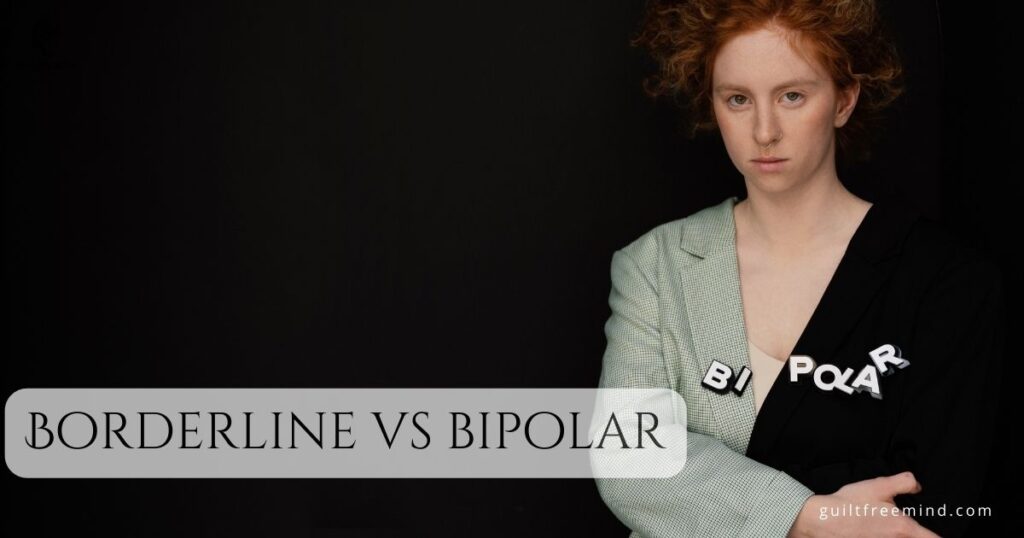
The manic or hypomanic and depressive episodes that characterize bipolar disorder are more distinct and persistent than those that characterize BPD. Sleep disruptions, emotional stress, certain medications, and substance abuse are just a few of the many potential causes of a manic or depressed episode. This is not the case in BPD.
Who is at risk of developing bipolar disorder?
The onset of bipolar disorder is unpredictable. Onset often occurs around age 25, though it can occur as early as age 10 or as late as age 50.
Despite having an equal number of incidences in both who are assigned female at birth (AFAB) and assigned male at birth (AMAB), bipolar disorder typically manifests itself differently in the two genders.
Those who are AFAB show rapid mood swings. If a person with bipolar disorder has four or more manic or depressive episodes in a year, this is known as “rapid cycling.” The most common cause of this is the variation in the levels of the sex and thyroid hormones. Unfortunately, females are given more antidepressants than men which in turn, boosts the propensity for mood swings. They are also more likely to suffer from depression. About 5.7 million adult Americans, or 2.6% of the population, have bipolar illness.
Effect of bipolar disorders on daily life
Bipolar disorder like any other mental health condition can have a severe impact on a person’s daily life and interpersonal relationships. The manic highs and depressive lows that characterize this disorder can make it difficult for a person to carry out daily tasks and stick to a schedule. Individuals with manic episodes may exhibit dangerous actions and jeopardize their relationships because of their heightened energy, recklessness, and lack of judgment.
Negative effects on personal and professional relationships might arise from depressive episodes due to the person’s extreme unhappiness, lack of interest, and withdrawal from social activities. The unpredictability of bipolar disorder makes it difficult for people to keep their lives together and fulfill their responsibilities, which can result in problems at work, financial instability, and constant negative emotions like guilt and shame. Understanding how bipolar disease can affect day-to-day functioning and interpersonal relationships is critical for identifying signs of the disorder and deciding whether or not to seek treatment.
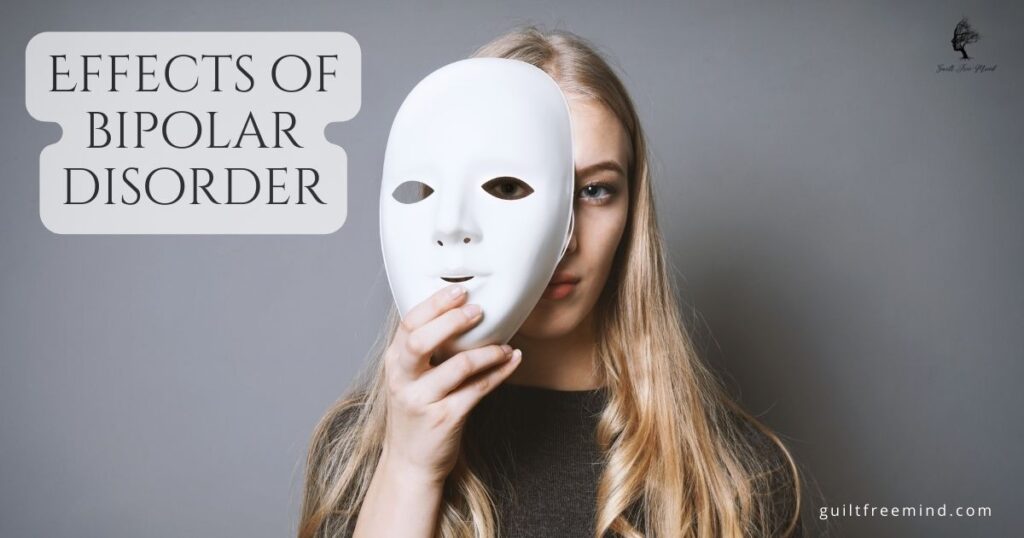
Signs and symptoms of bipolar disorders
In the case of bipolar II disorders and cyclothymia, the most common characteristic is hypomanic episodes. On the other hand, in the case of bipolar I disorder, the most common characteristic is a manic episode lasting for at least one week.
Many patients with bipolar disorder, also suffer from periods of hypomania or mania in addition to depression. Mood swings aren’t always predictable and do not follow a pattern. The depressive episodes also may not follow manic ones. There is also the possibility that a person may cycle through the same negative mood numerous times, with happy periods in between. Bipolar disorder is characterized by rapid and extreme shifts in mood that can occur over weeks, months, or even years.
One defining feature of these mood shifts is that they represent a radical break from the person’s typical personality and may last for an extended period. In case of depression, this can be many weeks or months, and many days or weeks in the case of mania. Most people, and even the same individual at various points in time, experience depression and mania to varying degrees.
Signs of mania
Manic or hypomanic episodes are common in people with bipolar disorder. However, not everyone experiences them in the same fashion. Some people have repeated episodes while others may experience them very rarely.
Symptoms of a manic episode:
- Excessive joy, expectation, and eagerness.
- Mood swings, from happy to furious and nasty in a matter of minutes.
- Restlessness.
- Speedy verbal and mental processes.
- Enhanced vitality and less sleep requirement.
- Poor decision-making and increased impulsivity, such as quickly leaving a job.
- Planning for unattainable goals.
- Indulging in dangerous acts like unprotected sexual activity, substance abuse, and other forms of recklessness.
- Possessing an inflated sense of one’s importance, talent, or power.
- Experiencing psychotic episodes: hallucinations and/or delusions.
Hypomania symptoms
- Milder manic symptoms can be present in some people with bipolar illness. In medical terms, this is known as hypomania. Hypomania can cause elevated mood and the sensation that you have increased productivity. It is common for people with hypomania to perform adequately in everyday life and the workplace.
- During a hypomanic episode, you might not realize anything is wrong with you. However, those close to you may interpret your recent mood and activity shifts as out of the ordinary. It’s possible to go into a deep depression once the hypomania is over.
Symptoms of depression
Depressive episodes in bipolar disorder present similarly to major depressive episodes. Those things are:
- A crushing sense of loss.
- Weakness and exhaustion.
- Insufficient drive.
- Despair or a lack of self-esteem.
- The inability to take pleasure in past experiences.
- Trouble focusing and determining what to do next.
- Crying that can’t be stopped.
- Irritability.
- The necessity for sleep has grown.
- Sleeplessness or oversleeping.
- A shift in eating habits can lead to either weight loss or gain.
- Suicidal ideation
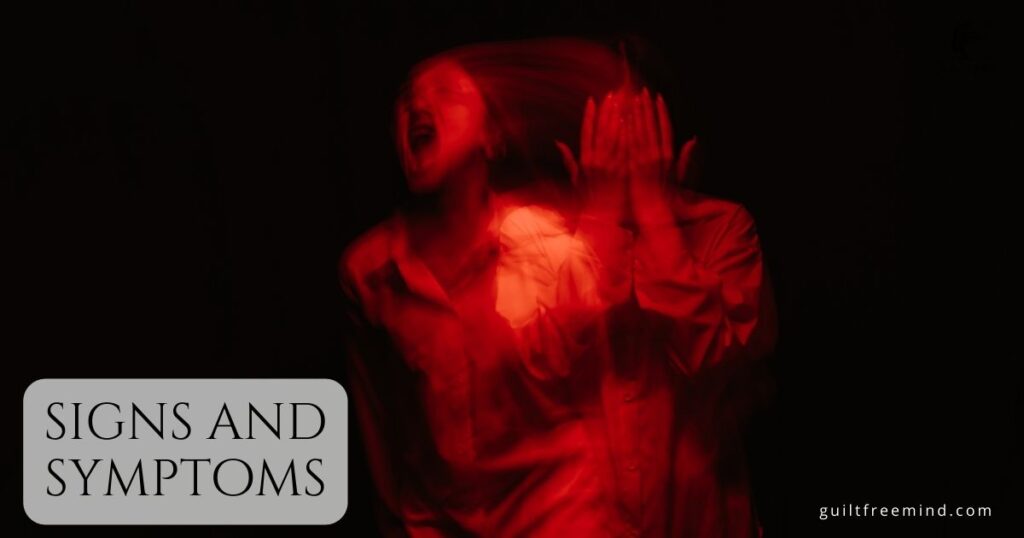
Symptoms of a mixed-episode
A mixed episode is characterized by the co-occurrence of manic and depressed symptoms. Depression-like symptoms are present during a mixed episode, but so are feelings of agitation, restlessness, and increased energy. Mixed episodes are considered extremely distressing by many who have bipolar disorder.
Early diagnosis is crucial for bipolar disorder treatment
There are several compelling arguments in favor of seeking out a bipolar illness diagnosis as soon as possible. First, a proper diagnosis helps people comprehend and make sense of their inner worlds and feelings. It shows them that they are not alone in their troubles and that their symptoms do have a medical basis. Rapid access to effective treatment is another benefit of early diagnosis. Because of its persistent nature, bipolar disorder treatment must be ongoing. Early identification allows for the initiation of tailored interventions including medication and counseling.
It encourages people to find their ways of dealing with problems, build their communities of support, and make educated choices about their health and wellness. Early diagnosis and treatment of bipolar disorder increase the likelihood that a patient will achieve stability, enhance their quality of life, and successfully manage their condition.
Finding the best professional for bipolar disorder treatment
Seek recommendations
If you or someone you know is struggling with bipolar disorder or mental health issues, it might be helpful to get recommendations from someone you trust, such as your primary care physician, mental health professionals, friends, or family.
Look for doctors with experience
Look for doctors who have experience with bipolar illness treatment or who specialize in treating mood disorders. Verify their knowledge by looking into their academic background, work experience, and professional memberships.
Check health insurance plans
If you have health insurance and want to see if mental health is covered, you should contact your insurance company. Get in touch with your insurance company to get a referral to a provider in their network who has experience treating bipolar disorder.

Schedule the first consultation
Consultations should be scheduled once a shortlist of potential doctors has been compiled. You can get to know them, voice your concerns, and observe how they handle patients. Remember to ask questions to get to know your healthcare professional better. Consultation questions should probe the doctor’s knowledge of bipolar disorder, philosophy of care, and strategies for treating the condition. Ask questions about the treatments and medications they advise, their appointment availability, and how they prefer to provide information.
Focus on the rapport
Take into account your level of comfort and the connection you share with your doctor. Think about how effectively you connect with them throughout the consultation, as trust and open communication are vital in a therapeutic relationship.
Get a second opinion
Don’t be afraid to get a second opinion if you have doubts about a doctor’s diagnosis or treatment plan. It can help you better understand your condition and treatment options.
Focus on the practical considerations
Think about the provider’s location, hours of operation, and accessibility while evaluating the logistics and practicalities. Determine if it is feasible to use their services, in terms of both transportation and schedule, given your demands and preferences.
Take your time
Take the time to do your homework and talk to multiple professionals before settling on a healthcare provider to treat your bipolar disorder. Think about their level of knowledge, their personality, their availability, and their pragmatism.
Bipolar disorder treatment with medications
Mood stabilizers
Mood stabilizers are the most common type of treatment for bipolar disorder. Both manic and depressed episodes reduce with their guidance. The usage of lithium as a mood stabilizer dates back decades. Carbamazepine and lamotrigine are two other mood stabilizers besides valproic acid (valproate).
Atypical antipsychotics
Mood stabilizers and atypical antipsychotics are common treatment regimes for schizophrenia and bipolar disorder. They are useful for treating and preventing bouts of manic or mixed mania. Aripiprazole, olanzapine, quetiapine, risperidone, and ziprasidone are atypical antipsychotics used for treat bipolar disorder.
Antidepressants
Bipolar disorder patients experiencing a depressive episode may benefit from a cautious trial of antidepressant medication. To reduce manic or hypomanic episodes, these are frequently used with mood stabilizers. In such circumstances, doctors may recommend antidepressants like selective serotonin reuptake inhibitors (SSRIs).

Benzodiazepines
Short-term usage of benzodiazepines, such as lorazepam or clonazepam, may be given to treat the extreme anxiety or insomnia that often accompanies bipolar disorder. Due to the risk of dependence and sedation, they are not recommended regularly.
The right medication or combination for one person may not work at all for another. A healthcare provider will thoughtfully decide which medications to prescribe, taking into account the patient’s symptoms, history of therapy, tolerance for probable side effects, and personal preferences.
Bipolar disorder treatment concerns and misunderstandings
Several myths and worries circulate about the use of medication to treat bipolar disorder. Their resolution is crucial so that people may make educated judgments based on reliable data. The following are some widespread worries and misunderstandings regarding bipolar disorders treatment:
Addiction
The potential for physical and psychological dependence on drugs causes many patients to avoid taking the drugs. However, there is a low risk of addiction to drugs for bipolar disorder if they are used as directed by a doctor. Medications are meant to help manage the symptoms, not cause euphoria or addiction.
Alterations in personality
Some people fear that taking medication would alter their personality or leave them feeling emotionless, both of which are extreme side effects. Mood-stabilizing drugs can assist but aren’t meant to change who you are. Medication is intended to lessen the severity of mood swings and improve a person’s ability to function, provided they are monitored and adjusted appropriately.
Side effects
Potential adverse consequences are a common source of anxiety. While some people may be more sensitive to or have more severe side effects from drugs, this is not the case for everyone. If you’re experiencing any negative effects from your treatment, be sure to tell your doctor so they can make modifications.

Medication as the only option
Some people with bipolar disorder may feel that medication is all they need, while others may avoid taking any kind of medicine at all. You must realize that bipolar disorder is a complicated illness that frequently calls for a combination of treatment modalities. Long-term management often involves a combination of medication, counseling, lifestyle changes, and social support.
Effectiveness of the medication
Some patients may question the efficacy of their treatment if they don’t feel better right away or if they have trouble identifying the appropriate drug or dosage. Remember that sometimes you just have to try different things to find the remedy that works best. It may take time for medications to take effect, and changes may be necessary along the way. Successful therapy requires the patient to be patient, persistent, and communicative with their healthcare professional.
Bipolar disorder treatment: benefits of medication
Treatment of bipolar disorder relies heavily on regular medication use. Key reasons why it’s crucial to take medications as prescribed are as follows:
Mood stabilization
Mood stabilizers and antipsychotics are most often used for bipolar disorder. They work by reducing both the frequency and severity of mood fluctuations. Taking medication as prescribed regularly improves the chances of obtaining and maintaining stable mood levels and avoiding or significantly reducing periods of mania and depression.
Prevention of relapse
Relapse prevention is a key component in the treatment of bipolar illness. Maintaining regular medication doses helps prevent mood episodes from returning. Symptom stability with regular medication use improves the quality of life and provides functional independence.
Boosts the effectiveness of treatment
To avoid a deterioration in their condition, patients with bipolar illness should not go untreated or undertreated. Maintaining regular medication dosages helps lessen the risk of suffering severe manic or depression episodes that might interfere with daily life.
Increased efficacy
Mood stabilizers don’t work as well unless they’re consistently present in patients’ bloodstreams. Medication is less likely to work if it is not taken consistently or if you miss doses. Individuals are more likely to reap the benefits of their medication if they take it consistently at prescribed times.

Better life quality
Medication adherence has been shown to considerably enhance the quality of life for those with bipolar disorder. Better functioning, better relationships, higher productivity, and higher well-being are all possible when moods are stable. Taking medication as prescribed helps people function normally, achieve their objectives, and feel in charge of their lives.
Boosts the effectiveness of treatment
Medication is typically used in conjunction with other forms of treatment, such as counseling, changes in lifestyle, and social networks, to increase the likelihood of a positive outcome. Medication adherence is an integral part of a good treatment plan for bipolar disorder since it ensures that the various components of the plan complement one another.
Psychotherapy and Counseling as bipolar disorder treatment
Treatment for bipolar disorder typically includes talking therapies like psychotherapy and counseling. They can aid in gaining insight into one’s situation, learning effective coping mechanisms, and enhancing one’s general sense of well-being. Some common psychotherapeutic and counseling methods for treating bipolar disorder are as follows:
Cognitive-Behavioral Therapy (CBT)
CBT aims to recognize and alter dysfunctional ways of thinking and behaving that underpin emotional and behavioral instability. One’s ability to deal with stress, solve problems, and cope with difficult situations can greatly benefit from this therapy. Mood disorders, insomnia, and medication noncompliance are some of the issues that you can manage with cognitive behavioral therapy.
Psychoeducation
Education regarding the nature of bipolar disorder, its signs and triggers, and available therapies is the focus of psychoeducation. It aids in the diagnosis, management of expectations, and treatment decisions of the affected person and their loved ones. Psychoeducation can also help with mood crises and the stresses of daily life.
Interpersonal and Social Rhythm Therapy (IPSRT)
IPSRT aims to establish and maintain healthy social and interpersonal routines. It aids in establishing regular sleeping, eating, and activity schedules, all of which are important because interruptions in any of these areas can lead to mood disorders. This technique also tackles relationship issues, interpersonal communication, and problem resolution.
Family-focused therapy
Family-Focused Therapy (FFT) is a type of psychotherapy in which members of the patient’s immediate family actively participate in their care. The purpose of this program is to strengthen family ties, facilitate better communication, and lessen the emotional strain on all family members. Through discussion of how bipolar disease affects family relationships, FFT encourages healthy methods for coping with the disorder as a unit.

Supportive therapy
Individuals with bipolar disorder need a compassionate and accepting environment in which to share their experiences, thoughts, and feelings. It provides individuals with the emotional support, affirmation, and encouragement they need to deal with the difficulties associated with living with the illness.
Group therapy
In a group setting, people with bipolar disorder can talk to others who understand what they’re going through. It’s a safe place to vent about difficulties, compare notes on how you’ve dealt with similar situations, and learn from the experiences of others. You can gain a sense of community and peer support via group therapy.
Bipolar disorder treatment with changes in lifestyle
The management of bipolar disorder includes lifestyle and self-care methods. They work in tandem with conventional medical treatment to further improvement in health and stability. Important self-care and lifestyle changes for those coping with bipolar disorder include the following:
Follow a daily regimen
Creating a daily regimen that you stick to can do wonders for your mood and your sense of well-being. The same goes for going to bed and waking up, as well as eating and doing other things. Maintaining a regular schedule can help stabilize mood and lessen the likelihood of manic episodes.
Prioritizing Sleep
People with bipolar disorder must get enough regular sleep. Promoting stability and warding off mood disruptions can be done by keeping a regular sleep schedule, engaging in excellent sleep hygiene (e.g., avoiding stimulants before bed, establishing a soothing sleep environment), and quickly resolving sleep disorders.
Manage stress
Mood episodes in people with bipolar disorder may be triggered by stress. Stress can be managed by the use of relaxation techniques including deep breathing exercises, mindfulness meditation, physical activity, and pursuing interests that bring one happiness. Finding constructive ways to deal with stress is important for mental health.
Diet
Support your physical and mental well-being with a diet full of fruits, vegetables, whole grains, lean meats, and healthy fats. Because of their potential to alter mood and interact badly with medications, coffee, alcohol, and other drugs should be avoided in excess.
Exercise
Physical exercise has many positive effects on mental health. Participating in regular physical activity, such as walking, running, swimming, or yoga, has been shown to boost mental health in several ways. Selecting activities that are both pleasurable and feasible is crucial.

Avoiding Substance addiction
Drug and alcohol addiction both worsen mood swings and reduce the efficacy of treatment. People who suffer from bipolar disorder should refrain from using illegal substances and cut back on their alcohol intake. If you have any questions about how your prescriptions can react with other substances, talk to your doctor.
Having a close friends circuit
Networking and relationship building are two of the most important things you can do for yourself. In times of difficulty, it can be comforting to have the love and support of friends, family, and peers who understand and can empathize. It might also be helpful to join a support group or go through therapy that focuses on improving communication and relating skills.
Identifying triggers
Individuals can gain the ability to respond effectively to mood episodes if they are aware of the warning indicators and actively watch for them. As part of this process, it may be helpful to keep a mood diary, in which one records their feelings, sleep habits, energy levels, and how they respond to treatment.
Staying in touch with professionals
It is crucial to keep an open line of communication with one’s healthcare professionals frequently. This involves going to visits as planned, communicating any changes in symptoms or drug side effects, and asking any questions or raising any concerns you may have. Working together with medical personnel allows for constant assessment of progress and alterations to the treatment plan as needed.
Bipolar Disorder Treatment: The Role of Social Support Systems and Peers
Treatment and management of bipolar disease can be greatly aided by both professional and peer support systems. Individuals with the illness can tremendously benefit from their compassion, understanding, and aid. Why it’s crucial to have a network of friends and peers to lean on:
Security
Peer support groups and social networks offer people with bipolar disorder a secure place to talk about their struggles and successes with others who understand their condition. Having supportive people around can make a huge difference in how people feel about themselves and their struggles. It helps people feel less alone and less judged for having mental health issues.
Emotional support
Emotional support is important for those dealing with the emotional challenges of bipolar disorder. Peer support groups and other forms of social support provide a safe space for people to share their experiences and receive understanding feedback from their peers. Emotional anguish reduces and the patient gains a sense of comfort and reassurance by sharing experiences, worries, and triumphs with people who can relate.
Learning new methods
Peer support groups and other social networks can be a great resource for learning effective techniques for living with bipolar disorder. The members share insights, suggestions, and strategies with each other. Individuals can gain the tools they need to manage their own lives and create healthy coping mechanisms by reading about the experiences of others.
Knowledge
Peer support groups frequently provide members with access to bipolar disorder-specific instructional materials and general knowledge. Individuals and their loved ones can benefit from this psychoeducation by learning more about the disorder, its symptoms, possible treatments, and coping mechanisms. When people have access to up-to-date information, they are better able to make decisions about their care and treatment.

Empowerment
Inspiration and empowerment increase by interacting with other people who are also living with and managing bipolar disorder. Seeing the growth, perseverance, and recovery of others might give people who are going through something similar hope and inspiration. Individuals with the same disease can get inspiration and motivation from their peers through support groups.
Empathy and Advocacy
Peer support groups and other social networks can help people with bipolar disease get the help they need and the respect they deserve. Peer education can contribute to a more accepting and welcoming culture by increasing knowledge and decreasing prejudice. Furthermore, peers can understand the difficulties that someone is experiencing, lending a fresh viewpoint and validating the individual’s story.
Bipolar Disorder Treatment With Complementary and Alternative Medicine
Traditional therapies for bipolar disorder can be supplemented with complementary and alternative medicine for optimal results. Never attempt these procedures without first consulting a medical expert. Despite their potential usefulness, they are not replacements for tried-and-true medical care. Alternative and complementary therapies for bipolar disorder include the following:
Mindfulness
Those who suffer from bipolar disorder may find relief from their symptoms via the use of mindfulness techniques like meditation and deep breathing exercises. These methods have the potential to stabilize moods and enhance well-being.

Supplements
Some people try to improve their mental health with the help of herbal and nutritional supplements. S-adenosylmethionine (SAMe), and omega-3 fatty acids are just a few examples. However, before taking any supplements, it is vital to contact a healthcare practitioner because they can mix with drugs and may lack adequate scientific evidence supporting their efficacy.
Acupuncture
Acupuncture is a traditional Chinese medicine practice that includes inserting very tiny needles into the body at strategic spots. This method has shown to aid in the reduction of stress, anxiety, and the promotion of relaxation in some patients. However, additional studies are required to determine its efficacy for the treatment of bipolar disorder.
Light therapy
Light therapy is the practice of exposing a patient to strong light, similar to that of sunlight, using a lightbox or visor. While its primary usage is in the treatment of seasonal affective disorder (SAD), it has also shown promise in the treatment of bipolar disorder. Light treatment boosts mood, facilitates sleep, and regulates circadian rhythms.
How to Deal with Bipolar Disorder Triggers and Relapses
Dealing with triggers and relapses is a crucial part of treating bipolar disorder. People can keep their emotional equilibrium and have fewer mood episodes if they learn to recognize and control their triggers. Here are some methods to help you deal with relapses.
Recognize Individual Triggers
Different people experience mood swings for different reasons. These triggers might differ from person to person, so it’s crucial to learn to recognize them. Sleep deprivation, stress, substance addiction, traumatic life events, and changes in habit are common precipitating factors. Keeping a journal of your feelings can be useful in pinpointing causes and avoiding recurrences.
Create a plan
Work with a healthcare provider to create a plan to reduce the risk of relapsing, which should include measures to lessen the impact of triggers and safeguard against mood swings. Changes in diet and exercise, learning to relax, taking medications as prescribed, attending regular therapy sessions, and enlisting the help of loved ones are all possible components of such a plan. Every person’s plan has unique requirements and preferences.
Follow a schedule
Stabilize your mood and lessen the effect of triggers by establishing and sticking to a regular daily schedule. This includes sticking to regular hours for things like sleeping, eating, and doing other things. Stable routines bring comfort and aid in controlling circadian rhythms, both of which lessen the likelihood of emotional upheaval.
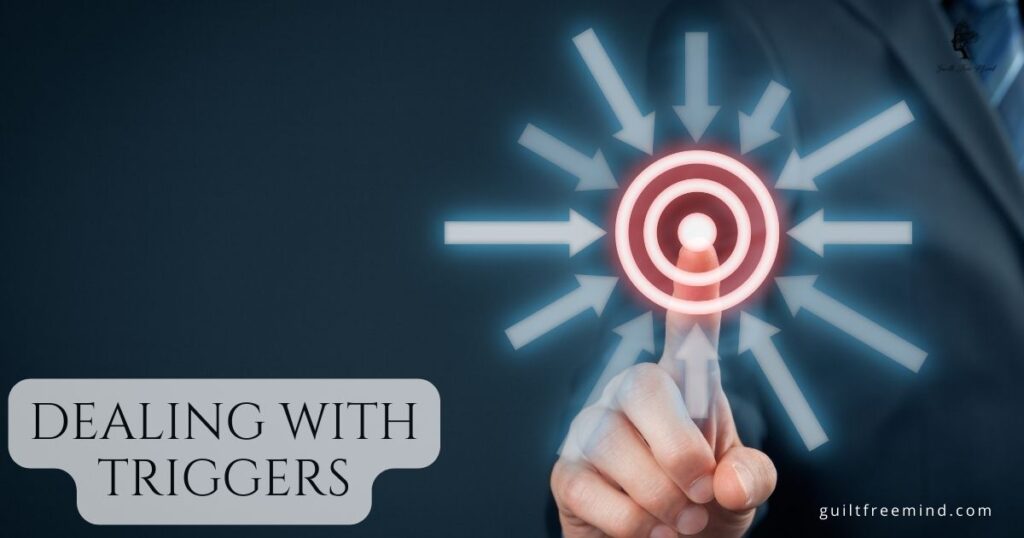
Keep in Touch with Your Doctors
It is crucial to keep in touch with your doctors regularly. Keep all appointments, tell your doctor about any changes in symptoms or side effects, and ask any questions or voice any concerns you have. Professional medical staff can advise patients, keep tabs on how well treatments are working, and make adjustments as needed.
Recognize Early Symptoms
Identifying the early symptoms of a mood episode will help you get help faster. Sleep disturbances, low energy, mood swings, and unusual behavior are all possible outcomes. By being on the lookout for these symptoms, people can take preventative measures and employ coping mechanisms promptly, lessening the likelihood and impact of relapses.
Modify Treatment Promptly
Seek Professional Help If Symptoms Worsen or Relapse Occurs. Medical professionals can assess those experiencing a relapse, make any necessary adjustments to treatment, and offer emotional support.
Conclusion
In conclusion, bipolar disorder treatment is complex and should be approached holistically. To effectively manage the disease and promote general well-being, a combination of medication, psychotherapy, lifestyle alterations, and support systems is used. To create a treatment plan tailored to each patient’s specific needs, it is essential to obtain a professional diagnosis as soon as possible.
Medicines help with mood and symptom stabilization in bipolar disorder. Long-term management requires strict adherence to prescribed medications and close collaboration with healthcare specialists to track their efficacy and any adverse effects.
People with bipolar disorder greatly benefit from psychotherapy and counseling. Mood instability can have emotional and psychological roots, and these interventions assist people understand and control their condition, as well as build coping mechanisms.
Treatment success increases through the use of social support systems and peer support groups, where members can feel comfortable opening up about their own experiences and learning from those of others.
If you want to know more about how to manage bipolar disorders, subscribe to Guilt Free Mind. The subscription option is present in the sidebar. If you like watching videos, please subscribe to the YouTube channel of Guilt Free Mind. Do not forget to hit the notification bell and set it to ALL. Please post your queries and questions in the comment section, I will answer them as soon as possible.
See you in my next blog post
